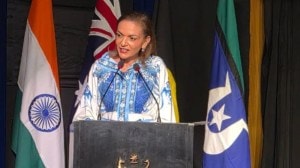Policy must fly
It is indeed a welcome resolve by the government to handle firmly any attempt to hijack aircraft in our territory. Interestingly, a newspape...

It is indeed a welcome resolve by the government to handle firmly any attempt to hijack aircraft in our territory. Interestingly, a newspaper followed up that announcement with an article on how the government should deal with a given scenario, with some imagination thrown in. The picture painted could be an interesting fiction but was far from reality. I am glad, nevertheless, that interest is being shown on aviation security. While a hijack is a possibility, it should be known that our interceptors that carry only air-to-air missiles could never target buildings. The rules of engagement in the air are very strict and precise.
The actions involved in intercepting a hijacked aircraft and managing the related crisis are complex. Shooting down of a civil aircraft could never happen unless it is to avoid an extreme catastrophe that becomes imminent and is authorised at a highly responsible level of the government. Clear decisions would be required in a matter of minutes and the tasks demand well-trained and disciplined professionals.
Besides a hijack, a civilian aircraft could be employed clandestinely on anti-national activities such as the Purulia arms drop a few years ago. Enquiries that followed the incident revealed many weaknesses. Civil and military air surveillance and control operate in watertight compartments. While there is agreement over the need to improve air vigilance and capabilities, much of the implementation remains on paper. Our air surveillance and interceptor assets have dwindled due to ageing. Significant portions of air corridors and important airspace in Indian territory lack active surveillance. Communication links need a major upgrade. It takes us years to decide on acquisitions and more to execute decisions! Adversarial elements, on the other hand, are better trained and well equipped.
It is difficult to maintain a high state of vigilance, which imposes a great strain on personnel and equipment. To keep such an organisation trim, intensive training is necessary, as also periodic exercises. The top-level decision-making body should also participate in directing and giving decisions. This would help them to take the best possible decisions in a real crisis situation. It is quite feasible to simulate the hijack of Kandahar or the Purulia type of incident to test and assess our efficacy. Such exercises are undertaken in the west most seriously and regularly.
Regrettably, it does not happen to the extent that is desirable in India. The west has taken a lead on combating terrorism in the air. The United Kingdom and France share the major burden of air surveillance over Europe. Over 10,000 flights per day transit France and a similar number across UK. The daily air traffic over India is just about 2,500 flights a day. Considering the territory of India is four times larger than France and the UK put together, the density of traffic over India is only a fraction of that occurring over France or UK. We could learn a lot from their experience on coordination and control. French Air Force interceptors frequently scramble day and night to shadow civil aircraft that had behaved suspiciously or had a doubtful origin. The US scans every passenger by name in every aircraft that transits its airspace. But the task of policing the sky and managing air traffic in India are difficult due to poor infrastructure and inefficiency. It is not unusual for airliners to keep circling over Delhi or Mumbai for half an hour or more, burning up expensive fuel, awaiting landing permission.
Civil and military assets could easily be integrated for effective surveillance and control of air traffic. This would help in saving costs and improve overall efficiency. Unfortunately, thus far the efforts to integrate them have failed. Experienced air force air traffic controllers were seconded to civil aviation to support. They spent three to four years at civil air traffic control but returned never having controlled air traffic! The reason was that they did not have a civil license. It is ironic that air force controllers manage the civil traffic at Pune, Jorhat, Jodhpur, Chandigarh, Agra, Srinagar, Leh and over many airfields that are under the air force without a civil license. To overcome this bureaucratic hurdle, the air force sent its military controllers on a course to Singapore to formally qualify them at a civil air traffic training school. It is regrettable that even after their return with the qualification, they were not permitted to handle air traffic because they could not be given the familiarisation or check out by a civil supervisor! I took up the matter a few times with the minister of civil aviation. I was given a patient hearing. But nothing significant happened on the ground. Divisions and inefficiencies continue.
We need to induct a number of modern surveillance radars and integrate the existing radar assets, both of the air force and civil. Air force interceptors need to operate from a larger number of bases. We need better navigational and airfield recovery aids to facilitate all-weather operations. There is a need to exercise real time monitoring and tighter control jointly by air force and civil aviation. This would permit considerable shortening of existing air corridors over the country and reduce the flying time between airports. This would significantly save expenditure and help to reduce the cost of air travel.
If resources are scarce, funds could be diverted from elsewhere. We could probably limit the build-up of strategic assets to save on expenditure if we believe that the ‘‘minimum deterrence’’ has been established. In any case, the extent of assets required to ensure ‘‘minimum credible nuclear deterrence’’ is highly debatable. The government should research the Cold War to draw lessons. Science and technology is driving strategic thinking instead of the other way around.
Civil aviation is going through an exciting and challenging period. Besides the fleet, surveillance and communication infrastructure must get due attention to enhance security and safety. It is imperative that an attitudinal change is brought about at the management and functional levels focusing on professionalism and teamwork. It will not be easy.
The writer is a former chief of air staff



- 01
- 02
- 03
- 04
- 05




























